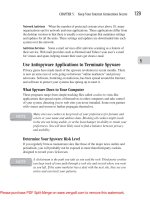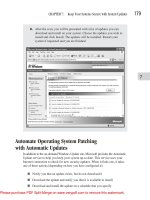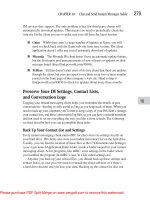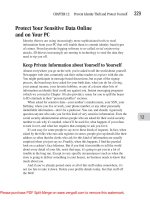how to do everything with ms office excel 2003 phần 6 docx
Bạn đang xem bản rút gọn của tài liệu. Xem và tải ngay bản đầy đủ của tài liệu tại đây (1.19 MB, 44 trang )
8. If you want to be able to use this query in the future, click the Save Query button and
specify the name in the resulting Save As dialog box. Excel’s default location for saving
queries is your %userprofile%\Application Data\Microsoft\Queries folder. You may
want to save the query elsewhere (for example, on a network drive) so that your
colleagues can use it as well.
Once you’ve saved a query, you can reuse it by choosing Choose Data | Import External
Data | New Database Query, selecting the query on the Queries tab of the Choose Data
Source dialog box, and clicking OK.
9. Click the Finish button. Excel displays the Import Data dialog box:
10. Specify whether to import the data into the current worksheet, into a new worksheet, or
to create a PivotTable with it. Then click the OK button. Excel imports the data in the
way you specified and displays the External Data toolbar:
The External Data toolbar offers these buttons for working with the data that you’ve imported:
■
Edit Query Relaunches the Query wizard for editing the query.
■
Data Range Properties Displays the External Data Range Properties dialog box
(shown here), which contains options for saving the query definition, protecting it with a
password, controlling how and when Excel refreshes the query, and specifying formatting
and layout options for the external data. These options are largely self-explanatory once
you know where to find them.
202 How to Do Everything with Microsoft Office Excel 2003
HowTo-Tght (8) / How to Do Everything with Microsoft Office Excel 2003 / Hart-Davis / 3071-1 / Chapter 9
Refresh All
Refresh StatusCancel RefreshEdit Query
Data Range Properties Refresh External Data
Query Parameters
P:\010Comp\HowTo8\071-1\ch09.vp
Wednesday, August 27, 2003 1:46:37 PM
Color profile: Generic CMYK printer profile
Composite Default screen
9
CHAPTER 9: Organize Data with Excel Databases 203
HowTo-Tght (8) / How to Do Everything with Microsoft Office Excel 2003 / Hart-Davis / 3071-1 / Chapter 9
■
Query Parameters Displays the Parameters dialog box, in which you can check or
change the parameters for the query:
■
Refresh External Data Forces an immediate refresh of the active external range.
■
Cancel Refresh Cancels an ongoing refresh (for example, if it’s taking too long).
■
Refresh All Forces immediate refreshes of all external ranges in the active workbook.
■
Refresh Status Displays the External Data Refresh Status dialog box, which shows
you which query is being refreshed and enables you to stop the refresh. This dialog box
is useful when you’re trying to refresh all external ranges and need to see which refresh is
getting stuck.
You can also refresh the data by choosing Data | Refresh External Data.
P:\010Comp\HowTo8\071-1\ch09.vp
Wednesday, August 27, 2003 1:46:37 PM
Color profile: Generic CMYK printer profile
Composite Default screen
204 How to Do Everything with Microsoft Office Excel 2003
HowTo-Tght (8) / How to Do Everything with Microsoft Office Excel 2003 / Hart-Davis / 3071-1 / Chapter 9
Customize a Query with MS Query
By using MS Query, you can create a custom query that contains only the data you need, or a
parameter query that enables you to specify values for given parameters each time you refresh
the data.
To create either kind of query, follow these steps:
1. Follow steps 1 to 6 of the procedure in the previous section, “Link to a Database with the
Query Wizard,” to run the Query wizard and define your query.
2. On the Query Wizard - Finish screen, select the View Data or Edit Query in MS
Query option.
3. Click Finish. The Query wizard displays MS Query.
4. If the Criteria fields aren’t visible, click the Show/Hide Criteria or choose View | Criteria
to display them.
5. Define criteria for the query (see the following sections for details).
6. Save the query by choosing File | Save, specifying the name and location in the Save As
dialog box, and clicking the OK button.
7. Choose File | Return Data to Microsoft Excel to return the data from the query to Excel.
Creating a Custom Query
To create a custom query, proceed to step 5 in the “Customize a Query with MS Query”
procedure, and then define criteria by following these steps:
1. Click in the first Criteria Field box and select the field you want to use for the criteria
from the resulting drop-down list.
2. In the first Value field, enter the value for the field. Figure 9-3 shows a query under
construction.
3. Add further criteria as necessary. When you move the focus from the first Value field,
MS Query displays the Enter Parameter Value dialog box with the prompt you set.
4. If necessary, choose Criteria | Remove All Criteria to remove all criteria, and then start again.
Creating a Parameter Query
To create a parameter query, proceed to step 5 in the “Customize a Query with MS Query”
procedure, and then follow these steps:
1. Click in the first Criteria Field box and select the field you want to use for the criteria
from the resulting drop-down list.
P:\010Comp\HowTo8\071-1\ch09.vp
Wednesday, August 27, 2003 1:46:37 PM
Color profile: Generic CMYK printer profile
Composite Default screen
9
2. In the Value field below the Criteria Field box, type an opening bracket ([), the prompt
that MS Query should display to elicit the information from you, and a closing bracket (]).
For example:
CHAPTER 9: Organize Data with Excel Databases 205
HowTo-Tght (8) / How to Do Everything with Microsoft Office Excel 2003 / Hart-Davis / 3071-1 / Chapter 9
FIGURE 9-3 Use MS Query to create a custom query for extracting information from a
database.
P:\010Comp\HowTo8\071-1\ch09.vp
Wednesday, August 27, 2003 1:46:38 PM
Color profile: Generic CMYK printer profile
Composite Default screen
3. Add further criteria as necessary. When you move the focus from the first Value field,
MS Query displays the Enter Parameter Value dialog box with the prompt you set:
After creating a parameter query and returning to Excel, you can change the criteria for the
query by clicking the Refresh button (or choosing Data | Refresh External Data Source). Excel
displays an Enter Parameter Value dialog box for each criterion you defined. When you’ve
specified criteria, Excel returns the records that match them.
Perform Web Queries
Excel can also extract data from tables in web pages by using its built-in Web Query feature. To
use Web Query, follow these steps:
1. Open Internet Explorer and browse to the page that contains the table you’re interested in.
2. Select a table or a cell, right-click, and choose Copy from the shortcut menu to copy it to
the Clipboard.
3. Activate Excel and the worksheet in which you want the data to appear.
4. Right-click the cell in which the upper-left corner of the data should appear, and choose
Paste from the shortcut menu.
5. Click the Paste Options Smart Tag that results from the Paste operation, and choose the
Create Refreshable Web Query option. Excel displays the New Web Query dialog box
with a black-on-yellow arrow next to each available table on the page:
206 How to Do Everything with Microsoft Office Excel 2003
HowTo-Tght (8) / How to Do Everything with Microsoft Office Excel 2003 / Hart-Davis / 3071-1 / Chapter 9
P:\010Comp\HowTo8\071-1\ch09.vp
Wednesday, August 27, 2003 1:46:38 PM
Color profile: Generic CMYK printer profile
Composite Default screen
9
6. Click the arrow for each table or cell you want to add. Excel changes the arrow to a
black-on-green check mark.
7. Click the Options button to display the Web Query Options dialog box (shown next) and
specify the import settings you want to use for the table. The most important settings are
the options in the Formatting section, which enable you to choose among full HTML
formatting, rich-text formatting, and no formatting (plain text). You can also specify
import settings for preformatted blocks, disable date recognition, and disable web query
redirections. Click the OK button to close the Web Query Options dialog box and return
to the New Web Query dialog box.
CHAPTER 9: Organize Data with Excel Databases 207
HowTo-Tght (8) / How to Do Everything with Microsoft Office Excel 2003 / Hart-Davis / 3071-1 / Chapter 9
P:\010Comp\HowTo8\071-1\ch09.vp
Wednesday, August 27, 2003 1:46:38 PM
Color profile: Generic CMYK printer profile
Composite Default screen
8. Click Import. Excel creates a live link in the worksheet to the table on the web page.
You can also perform a web query by choosing Data | Import External Data | New Web
Query and typing the URL in the New Web Query dialog box. In most cases, using copy and
paste, as described in the previous procedure, is faster and easier.
After creating the link, you can refresh the data in the link by selecting it and clicking the
Refresh button on the External Data toolbar. To refresh all of the links on the active worksheet,
click the Refresh All button.
208 How to Do Everything with Microsoft Office Excel 2003
HowTo-Tght (8) / How to Do Everything with Microsoft Office Excel 2003 / Hart-Davis / 3071-1 / Chapter 9
P:\010Comp\HowTo8\071-1\ch09.vp
Wednesday, August 27, 2003 1:46:38 PM
Color profile: Generic CMYK printer profile
Composite Default screen
HowTo-Tght (8) / How to Do Everything with Microsoft Office Excel 2003 / Hart-Davis / 3071-1 / Chapter 10
blind folio 209
Chapter 10
Outline and
Consolidate
Worksheets
P:\010Comp\HowTo8\071-1\ch10.vp
Wednesday, August 27, 2003 2:16:45 PM
Color profile: Generic CMYK printer profile
Composite Default screen
How to…
■
Use outlining to create collapsible worksheets
■
Create a standard outline automatically
■
Create a custom outline manually
■
Expand and collapse an outline
■
Change an outlined area after adding or deleting material
■
Remove an outline from a worksheet
■
Consolidate multiple worksheets into one worksheet by position or by category
■
Update or change an existing consolidation
E
ven if you don’t create databases (as described in Chapter 9), Excel worksheets can grow
so that they’re far longer than will fit on even the highest-resolution display. Working with
monster worksheets tends to be awkward and time-consuming, especially when you need to scroll
frequently to view the relevant parts of the worksheet. In the first part of this chapter, you’ll learn
how to use Excel’s outlining features to create a collapsible worksheet. By defining a hierarchy
for a worksheet, you can collapse it to its key areas, which—with any luck—you can fit on
screen at the same time.
Another problem you’re likely to run into when using Excel at work is needing to integrate
data from multiple similar worksheets into a single worksheet. You may need to do this for a
variety of reasons—from turning an archive of workbooks into a single useful resource to
circulating a workbook amongst your colleagues to gather necessary input. Integrating multiple
worksheets manually tends to be a long and thankless task, but Excel’s tools for consolidating
worksheets can save you a great deal of time and effort.
Use Outlining to Create Collapsible Worksheets
For extensive worksheets built around some form of hierarchy, Excel’s outlining tools can prove
invaluable. For example, the sales worksheet shown in Figure 10-1 tracks the sales of products by
reps, groups of reps, and regional offices, and by months, quarters, and years. In its normal state,
as shown in the upper part of the figure, the worksheet extends across many columns and down
through nearly 30 rows. But when the worksheet has an outline applied to it, you can collapse it
to any various levels to display different amounts of information. The lower part of the figure
shows the worksheet with outlining applied and the result partially collapsed.
As you saw in Chapter 4, you can hide columns or rows that you don’t want to have
displayed by choosing Format | Column | Hide or Format | Row | Hide. You can use
hiding to produce a similar effect to collapsing, but it’s so much slower and clumsier
that doing so is seldom worthwhile.
210 How to Do Everything with Microsoft Office Excel 2003
HowTo-Tght (8) / How to Do Everything with Microsoft Office Excel 2003 / Hart-Davis / 3071-1 / Chapter 10
P:\010Comp\HowTo8\071-1\ch10.vp
Wednesday, August 27, 2003 2:16:45 PM
Color profile: Generic CMYK printer profile
Composite Default screen
10
CHAPTER 10: Outline and Consolidate Worksheets 211
HowTo-Tght (8) / How to Do Everything with Microsoft Office Excel 2003 / Hart-Davis / 3071-1 / Chapter 10
FIGURE 10-1 If a worksheet contains a hierarchy, you can use outlining to collapse it.
P:\010Comp\HowTo8\071-1\ch10.vp
Wednesday, August 27, 2003 2:16:46 PM
Color profile: Generic CMYK printer profile
Composite Default screen
An outline can have up to eight outline levels for rows and up to eight outline levels for
columns, enabling you to create highly collapsible worksheets. The outline shown in the lower
part of Figure 10-1 has four outline levels for rows and four for columns.
Create a Standard Outline Automatically
To create a standard outline in an Excel worksheet, follow these general steps:
1. Lay out the basic framework of the outline and enter the formulas in the appropriate places:
■
Excel creates the outline based on where the formulas are entered in the worksheet, so
you must enter the formulas in the worksheet before you can create an outline in it.
■
You don’t have to enter all the items within any particular category, because you can
insert rows and columns in the data area without disrupting the outline applied.
Excel simply expands the outline to accommodate the extra rows or columns.
2. To create a single outline for the whole of the current data area, select a cell in the data
area. To create an outline for only a specific part of the current data area, select the range.
3. Choose Data | Group and Outline | Auto Outline to create an automatic outline for the
whole data area or for the current selection.
Chose Custom Settings for Outlining
Excel’s default settings for outlining work well with worksheets laid out like the worksheet shown
in Figure 10-1, with summary rows below the detail rows and summary columns to the right of
the detail columns. To outline a worksheet that has its summary rows above the detail rows, or its
summary columns to the left of the detail columns, you need to change the outlining settings.
To choose custom settings for outlining, follow these steps:
1. Choose Data | Group and Outline | Settings to display the Settings dialog box (Figure 10-2).
2. Choose options as appropriate:
■
Clear the Summary Rows Below Detail check box (which is selected by default) if
the summary rows are above the detail rows.
■
Clear the Summary Columns to Right of Detail check box (which is selected by
default) if the summary columns are to the left of the detail columns.
■
If you want Excel to automatically apply styles to the outline, select the Automatic
Styles check box. Excel uses styles named RowLevel_1, RowLevel_2,
ColumnLevel_1, ColumnLevel_2, and so on to identify the different row levels and
column levels. Click the Apply Styles button to apply the styles to the outline.
3. Click the OK button to close the Settings dialog box and apply the custom settings to
the outline.
212 How to Do Everything with Microsoft Office Excel 2003
HowTo-Tght (8) / How to Do Everything with Microsoft Office Excel 2003 / Hart-Davis / 3071-1 / Chapter 10
P:\010Comp\HowTo8\071-1\ch10.vp
Wednesday, August 27, 2003 2:16:46 PM
Color profile: Generic CMYK printer profile
Composite Default screen
10
Create an Outline Manually
Instead of creating an outline automatically by using the Auto Outline command, you can build
an outline manually by using the Group command (and, if necessary, the Ungroup command).
Creating an outline manually is far more labor intensive than using Auto Outline, so it’s best kept
for occasions when Auto Outline doesn’t give you the results you need or when you need to build
an outline at the same time as you create a worksheet.
You can also use the Group and Ungroup commands to change the grouping of selected
rows or columns in an existing outline you’ve created using the Auto Outline command.
To create an outline manually, follow these steps:
1. Select the detail rows or detail columns that you want to group. The detail rows or detail
columns must be adjacent to each other for grouping to work.
2. Choose Data | Group and Outline | Group to display the Group dialog box:
3. Select the Rows option button or the Columns option button, as appropriate.
4. Click the OK button to close the Group dialog box and apply the grouping.
To ungroup grouped columns or rows, follow these steps:
1. Select the cells you want to affect.
CHAPTER 10: Outline and Consolidate Worksheets 213
HowTo-Tght (8) / How to Do Everything with Microsoft Office Excel 2003 / Hart-Davis / 3071-1 / Chapter 10
FIGURE 10-2 You can adjust Excel’s settings for outlines in the Settings dialog box.
P:\010Comp\HowTo8\071-1\ch10.vp
Wednesday, August 27, 2003 2:16:46 PM
Color profile: Generic CMYK printer profile
Composite Default screen
214 How to Do Everything with Microsoft Office Excel 2003
HowTo-Tght (8) / How to Do Everything with Microsoft Office Excel 2003 / Hart-Davis / 3071-1 / Chapter 10
2. Choose Data | Group and Outline | Ungroup to display the Ungroup dialog box:
3. Select the Rows option button or the Columns option button as appropriate.
4. Click the OK button to close the Ungroup dialog box and ungroup the rows or columns.
Expand and Collapse the Outline
Once you’ve applied an outline to a worksheet, you can expand and collapse it easily by using
the outline symbols that Excel displays (Figure 10-3):
■
Click one of the Column Level buttons to expand or collapse the columns to that level.
■
Click one of the Row Level buttons to expand or collapse the rows to that level.
■
Click an Expand button to expand a row level or column level, or click a Collapse button
to collapse a row level or column level.
If you have an IntelliMouse with a wheel, you can use it to expand or collapse the
outline. Hover the mouse pointer over the summary cell for a row, column, or both,
and then
SHIFT–scroll backward to collapse the outline or SHIFT–scroll forward to
expand the outline.
Change the Outlined Area After Adding or Deleting Material
If you add rows or columns to a worksheet that contains an outline, or delete rows or columns
from it, you need to redo the outline. To do so, choose Data | Group and Outline | Auto Outline
again, and then click the OK button in the dialog box that Excel displays asking whether you
want to modify the existing outline:
P:\010Comp\HowTo8\071-1\ch10.vp
Wednesday, August 27, 2003 2:16:46 PM
Color profile: Generic CMYK printer profile
Composite Default screen
10
Toggle the Display of the Outline Symbols
If screen space is at a premium, you may sometimes want to hide the outline symbols to prevent
them from consuming chunks of the top and left areas of the Excel window. To toggle the display
of outline symbols, follow these steps:
1. Choose Tools | Options to display the Options dialog box.
2. Click the View tab if it isn’t already displayed.
3. In the Windows Options section, clear the Outline Symbols check box to hide the outline
symbols, or select this check box to redisplay the symbols.
4. Click the OK button to close the Options dialog box and apply the change.
CHAPTER 10: Outline and Consolidate Worksheets 215
HowTo-Tght (8) / How to Do Everything with Microsoft Office Excel 2003 / Hart-Davis / 3071-1 / Chapter 10
FIGURE 10-3 Use the outline symbols to expand and collapse an outline.
Row Level buttons
Column Level buttons
Expand button
Collapse button
Column Level bar
Row Level bar
P:\010Comp\HowTo8\071-1\ch10.vp
Wednesday, August 27, 2003 2:16:47 PM
Color profile: Generic CMYK printer profile
Composite Default screen
If parts of the outline are collapsed when you hide the outline symbols like this, the
result can be confusing to anyone who doesn’t know that the worksheet contains an
outline. At first sight, the collapsed areas of the outline will appear to have rows or
columns hidden, but the user won’t be able to display these rows or columns by issuing
an Unhide command.
If you need to toggle the display of outline symbols frequently, you’ll probably find the path
through the Options dialog box too slow for comfort. To toggle the display of outline symbols
faster, customize a toolbar or menu to include the Show Outline Symbols command, which you’ll
find in the Data category on the Commands tab of the Customize dialog box. See “Customize
Toolbars” and “Customize Menus and Menu Bars,” in Chapter 17, for details on customizing
toolbars and menus.
Remove an Outline from a Worksheet
To remove an outline from a worksheet, choose Data | Group and Outline | Clear Outline.
Consolidate Multiple Worksheets into One Worksheet
Excel offers powerful features for automatically consolidating multiple worksheets into a single
worksheet. Such consolidation can be useful in a variety of situations, such as these:
■
Your predecessor created a workbook containing a single worksheet each week to show
the factory’s manufacturing output. You need to consolidate those worksheets into a
single worksheet to show the total output—and there are nearly a hundred worksheets.
■
You need to retrieve data from the same cell in each of a large number of worksheets in a
workbook. You could construct a complex formula or write a quick macro using Visual
Basic for Applications (VBA), but consolidation can take care of the problem more
quickly and easily.
■
You need to retrieve data from multiple worksheets that don’t have the same cell layout
(so you can’t specify the exact cell address) but that have the same row labels or column
labels. Excel can use the labels as reference points to retrieve the information you need.
This capability is especially useful when you’ve circulated copies of a worksheet to
colleagues, and you find they’ve inserted rows and columns in unsuitable places.
Excel can automatically consolidate up to 255 worksheets into a single worksheet. I’ll refer
to this worksheet as the destination worksheet and the underlying worksheets (the worksheets
from which the destination worksheet draws its data) as the source worksheets. You can choose
whether to link the destination worksheet to the source worksheets or to create a destination
worksheet that simply contains the data from the source worksheets but no link to them.
When you consolidate worksheets, the workbook that contains the destination worksheet
must be open. The workbook or workbooks that contain the source worksheets can be either
216 How to Do Everything with Microsoft Office Excel 2003
HowTo-Tght (8) / How to Do Everything with Microsoft Office Excel 2003 / Hart-Davis / 3071-1 / Chapter 10
P:\010Comp\HowTo8\071-1\ch10.vp
Wednesday, August 27, 2003 2:16:47 PM
Color profile: Generic CMYK printer profile
Composite Default screen
10
CHAPTER 10: Outline and Consolidate Worksheets 217
HowTo-Tght (8) / How to Do Everything with Microsoft Office Excel 2003 / Hart-Davis / 3071-1 / Chapter 10
open or closed—whichever you prefer. Having the source workbooks open tends to be better, for
a couple of reasons:
■
When you’re learning how to consolidate worksheets, you can see at a glance which data
Excel places where when you perform the consolidation.
■
If the workbooks are closed, you have to type relatively complex references to them; if
they’re open, you can create the references much more easily.
However, once you understand how consolidation works, you may prefer to leave the source
workbooks closed—particularly if you’re consolidating so many worksheets at once that having
all of their workbooks open on screen would be impractical.
If any source workbooks are open when you consolidate data from them, save them first.
Consolidate Worksheets by Their Position
The easiest way of consolidating worksheets automatically is consolidating by position. This
technique enables you to retrieve data from the same cell address in each of the source worksheets.
As you’d imagine, consolidating by position works successfully only if the same cell in each
of the source worksheets contains the relevant data. If you or your colleagues have changed the
layout of even a single worksheet by a single column, consolidating by position doesn’t work
correctly and can produce grossly incorrect results.
Consolidate Worksheets Manually
Using 3-D Formulas
If the source worksheets you need to consolidate don’t have consistent enough layout or
consistent labels to enable Excel to consolidate them automatically, you can consolidate them
manually by entering formulas that refer to the appropriate worksheets. This technique works
best if all the worksheets are in the same workbook, but it does work when the worksheets
are in different workbooks—provided that none of the workbooks are renamed or moved
after you create the formulas. See “Refer to Other Worksheets and Other Workbooks in
Formulas,” in Chapter 8, for instructions on creating formulas that refer to other worksheets
and other workbooks.
P:\010Comp\HowTo8\071-1\ch10.vp
Wednesday, August 27, 2003 2:16:47 PM
Color profile: Generic CMYK printer profile
Composite Default screen
218 How to Do Everything with Microsoft Office Excel 2003
HowTo-Tght (8) / How to Do Everything with Microsoft Office Excel 2003 / Hart-Davis / 3071-1 / Chapter 10
To consolidate worksheets by position, follow these steps:
1. Open the workbook that contains the destination worksheet.
2. To make entering the consolidation references as easy as possible, open each workbook
that contains one of the source worksheets. If the destination workbook contains the
source worksheets, you don’t need to take this step.
3. Activate the destination workbook and destination worksheet. For example, if you have
multiple workbooks open, use the Window menu to select the destination workbook, and
then click the worksheet tab for the destination worksheet to activate it.
4. Select the upper-left cell of the area in which you want to place the consolidated data.
5. Choose Data | Consolidate to display the Consolidate dialog box (Figure 10-4).
6. In the Function drop-down list, select the function you want to use for the consolidation.
The default function is Sum, which is what you’ll need for consolidating many worksheets,
but you can choose from Count, Average, Max, Min, Product, Count Nums, StdDev
(standard deviation), StdDevp (standard deviation based on an entire population), Var
(variance based on a sample), and Varp (variance based on an entire population).
7. Add the references by taking the following steps:
■
Click the Collapse Dialog button in the Reference box if you need to get the
Consolidate dialog box out of the way. Otherwise, you can just work around it.
■
If necessary, use the Window menu to activate the workbook that contains the
worksheet to which you want to refer.
This illustration shows a 3-D formula entered in cell B2 on the first worksheet (named
FY-2004) that refers to a different cell on each of the next four worksheets:
P:\010Comp\HowTo8\071-1\ch10.vp
Wednesday, August 27, 2003 2:16:47 PM
Color profile: Generic CMYK printer profile
Composite Default screen
10
■
Click the appropriate worksheet tab to activate it.
■
Select the cell or range of cells on the worksheet.
■
If you collapsed the Consolidate dialog box, click the Collapse Dialog button to
restore the dialog box.
■
Click the Add button to add the address or range to the All References box.
If the workbook that contains the worksheet isn’t open, click the Browse button and use
the resulting Browse dialog box to select the workbook. When you click the OK button
to close the Browse dialog box, Excel enters the workbook name in the Reference text
box for you. You then have to type the worksheet name and cell or range address to
enter the rest of the reference—for example, ‘[May Sales.xls]Week1’!$B$16.
8. Add further references in the same way. Excel’s default is to consolidate by position, so
Excel automatically suggests the same range when you click the tab of the next
worksheet you want to add to the consolidation.
9. Make sure the Top Row check box and the Left Column check box are cleared.
10. If you want to link the consolidation to the data source (so that Excel automatically
updates the consolidation), select the Create Links to Source Data check box. Otherwise,
make sure this check box is cleared (as it is by default).
11. Click the OK button to close the Consolidate dialog box. Excel consolidates the data into
the specified cells.
CHAPTER 10: Outline and Consolidate Worksheets 219
HowTo-Tght (8) / How to Do Everything with Microsoft Office Excel 2003 / Hart-Davis / 3071-1 / Chapter 10
FIGURE 10-4 Use the Consolidate dialog box to add the references for all the worksheets you
want to consolidate.
P:\010Comp\HowTo8\071-1\ch10.vp
Wednesday, August 27, 2003 2:16:48 PM
Color profile: Generic CMYK printer profile
Composite Default screen
220 How to Do Everything with Microsoft Office Excel 2003
HowTo-Tght (8) / How to Do Everything with Microsoft Office Excel 2003 / Hart-Davis / 3071-1 / Chapter 10
Consolidate Worksheets by Category
Consolidation by position is straightforward—provided that your colleagues haven’t changed the
layout of the worksheets by even a single cell. If the worksheets you need to consolidate have
even slightly different layouts, consolidation by position won’t work. But if the worksheets use
the same row labels and column labels, you may be able to consolidate by category instead.
Figure 10-5 shows an example of some worksheets that can’t be consolidated by position but
can be consolidated by category. Although the worksheets use the same general layout, the sales
assistants’ results are sorted in descending order so that they show which sales assistant sold the
most meat in that week. However, the labels in column A are consistent, so Excel can use them
to identify the cells.
To consolidate workbooks by category, follow these steps:
1. Open the workbook that contains the destination worksheet.
2. To make entering the consolidation references as easy as possible, open each workbook
that contains one of the source worksheets. If the destination workbook contains the
source worksheets, you don’t need to take this step.
3. Activate the destination workbook and destination worksheet. For example, if you have
multiple workbooks open, use the Window menu to select the destination workbook, and
then click the worksheet tab for the destination worksheet to activate it.
4. Select the destination area for the consolidated data. Include the row labels or column
labels that you’ll be using to identify the cells. In this example, I selected the range
containing the names of the sales assistants (A2:A7).
5. Choose Data | Consolidate to display the Consolidate dialog box.
6. In the Use Labels In group box, select the Top Row check box or the Left Column check
box as appropriate. For the example, I selected the Left Column check box.
7. In the Function drop-down list, select the function you want to use for the consolidation.
For the example, I left the default, Sum, selected.
8. Click in the Reference text box, and then add the references using the techniques
explained in step 7 of the previous section, “Consolidate Worksheets by Their Position.”
You’ll need to select the range manually on each source worksheet.
9. If you want to link the consolidation to the data source, select the Create Links to Source
Data check box. Otherwise, make sure this check box is cleared (as it is by default).
10. Click the OK button to close the Consolidate dialog box. Excel consolidates the data into
the specified cells.
P:\010Comp\HowTo8\071-1\ch10.vp
Wednesday, August 27, 2003 2:16:48 PM
Color profile: Generic CMYK printer profile
Composite Default screen
10
CHAPTER 10: Outline and Consolidate Worksheets 221
HowTo-Tght (8) / How to Do Everything with Microsoft Office Excel 2003 / Hart-Davis / 3071-1 / Chapter 10
Update an Existing Consolidation
To update an existing consolidation, follow these steps:
1. Select the upper-left cell in the consolidation.
2. Choose Data | Consolidate to display the Consolidate dialog box.
3. Click the OK button. Excel updates the consolidation using the existing references.
FIGURE 10-5 When you can’t consolidate by position because the worksheets use different
layouts, you may be able to consolidate by category instead by specifying the
appropriate labels.
P:\010Comp\HowTo8\071-1\ch10.vp
Wednesday, August 27, 2003 2:16:48 PM
Color profile: Generic CMYK printer profile
Composite Default screen
Change an Existing Consolidation
If you chose not to create links from the destination worksheet to its source worksheets in a
consolidation, you can change the consolidation without redoing it from scratch. To change a
consolidation, follow these steps:
1. Select the upper-left cell of the consolidated data.
2. Choose Data | Consolidate to display the Consolidate dialog box.
3. Change the details of the consolidation as necessary:
■
To add another source range, click in the Reference text box, specify the range as
usual, and click the Add button.
■
To remove an existing source range, select it in the All References list box and
click the Delete button.
■
To change an existing source range, select it in the All References list to display its
details in the Reference text box. Change it either by typing corrections or by using
the Collapse Dialog button and standard selection techniques, and then click the Add
button to apply the change.
■
To link the consolidation to its source data, select the Create Links to Source Data
check box. Take this step last, because creating the links prevents you from changing
any of the source ranges.
4. Click the OK button to close the Consolidate dialog box and apply the changes.
If you created your consolidation by entering formulas manually, you’ll need to edit
those formulas manually to change the consolidation.
222 How to Do Everything with Microsoft Office Excel 2003
HowTo-Tght (8) / How to Do Everything with Microsoft Office Excel 2003 / Hart-Davis / 3071-1 / Chapter 10
P:\010Comp\HowTo8\071-1\ch10.vp
Wednesday, August 27, 2003 2:16:48 PM
Color profile: Generic CMYK printer profile
Composite Default screen
Chapter 11
Analyze Data Using
PivotTables and
PivotCharts
HowTo-Tght (8) / How to Do Everything with Microsoft Office Excel 2003 / Hart-Davis / 3071-1 / Chapter 11
blind folio 223
P:\010Comp\HowTo8\071-1\ch11.vp
Thursday, August 28, 2003 12:04:18 PM
Color profile: Generic CMYK printer profile
Composite Default screen
224 How to Do Everything with Microsoft Office Excel 2003
HowTo-Tght (8) / How to Do Everything with Microsoft Office Excel 2003 / Hart-Davis / 3071-1 / Chapter 11
How to…
■
Understand PivotTables
■
Create a PivotTable framework using the PivotTable and PivotChart Wizard
■
Create a PivotTable on a PivotTable framework
■
Change, format, and configure a PivotTable
■
Create PivotCharts from PivotTables
■
Create a conventional chart from PivotTable data
A
fter entering a substantial amount of data in a database (as discussed in Chapter 9), or after
consolidating multiple worksheets into a single worksheet (Chapter 10), you may want
to manipulate the data to see what conclusions you can draw from it. This chapter and the next
introduce you to the tools for drawing those conclusions.
In this chapter, you’ll learn how to create and use PivotTables and PivotCharts, two powerful
tools for manipulating and analyzing data contained in databases. In the next chapter, you’ll see
how to solve problems by performing what-if analysis on your data.
Understand PivotTables
A PivotTable is a form of report that works by rearranging the fields and records in a database into
a different format. You can rotate (pivot) the columns in a PivotTable to display data summarized
in different ways, easily sort the database in various ways, filter data, and collapse and expand the
level of information displayed.
The PivotTable creates a PivotTable field from each field in the database (each column, in the
default orientation). Each PivotTable field contains items that summarize the rows of information
that contain a particular entry.
Creating and manipulating the PivotTable doesn’t change the contents or layout of the database,
so you can safely use a PivotTable to experiment with your data without worrying about corrupting
the data or needing to restore the database’s layout afterwards. A PivotTable also enables you to
perform what would otherwise be relatively complex calculations by using its built-in features.
If PivotTables seem mysterious, don’t worry—that’s a normal reaction. The best way to
come to grips with PivotTables is by using them to experiment with practice data over
which you have control, or with a spare copy of real data that you can reduce to an
easily manageable quantity, when you’re not under pressure of time to deliver results.
Until you start using data in a PivotTable, the features and benefits of a PivotTable tend to be
hard to grasp. Figure 11-1 shows a section of a database that I’ll use for examples in the rest of
this section. The database tracks sales of a microbrewery’s products by category (strong ales, standard
P:\010Comp\HowTo8\071-1\ch11.vp
Thursday, August 28, 2003 12:04:18 PM
Color profile: Generic CMYK printer profile
Composite Default screen
11
CHAPTER 11: Analyze Data Using PivotTables and PivotCharts 225
HowTo-Tght (8) / How to Do Everything with Microsoft Office Excel 2003 / Hart-Davis / 3071-1 / Chapter 11
ales, health products, animal feedstuffs, and so on), item, date (year and month, in separate columns),
the sales representative, the sales amount, the customer, and so on. The illustration shows only
the most interesting fields for our present purposes, leaving out various other fields (such as when the
order was posted, when it was fulfilled, and when it was paid).
You can use a PivotTable to ask the data questions, such as:
■
Which of our categories of product are waxing and which are waning?
■
Who are the key customers we should concentrate on?
■
How do our sales this year compare to our sales in another year?
■
Which rep sells most (or least) of which product? (Depending on your business
circumstances, you might formulate the question this way: Should we refocus any
particular rep on another product?)
You’ll see examples of manipulating the sample database to deliver answers to such questions
later in this chapter.
Create a PivotTable Framework Using
the PivotTable and PivotChart Wizard
To create a PivotTable framework, follow these steps:
1. Open the workbook that contains the database you want to manipulate.
2. Display the worksheet that contains the database, and click a cell in the database. To use
a specific range of the database instead of the whole database, select that range.
FIGURE 11-1 The example database I’ll use for demonstrating PivotTables
P:\010Comp\HowTo8\071-1\ch11.vp
Thursday, August 28, 2003 12:04:19 PM
Color profile: Generic CMYK printer profile
Composite Default screen
226 How to Do Everything with Microsoft Office Excel 2003
HowTo-Tght (8) / How to Do Everything with Microsoft Office Excel 2003 / Hart-Davis / 3071-1 / Chapter 11
3. Choose Data | PivotTable and PivotChart Report. Excel displays the first screen of the
PivotTable and PivotChart Wizard:
4. Make sure the Microsoft Excel List or Database option button and the PivotTable option
button are selected, and then click the Next button. The wizard displays its second screen:
You can also use the PivotTable and PivotChart Wizard to create PivotTable reports
(and PivotCharts) from data sources external to Excel—for example, by using MS
Query to return data from a database. See “Link an Excel Worksheet to an External
Database,” in Chapter 9, for information on using external data sources with Excel.
5. Enter the database range in the Range text box:
■
If you selected a cell in the database in step 2, the wizard should have identified the
range that contains the database. (See “Understand What an Excel Database Is,” in
Chapter 9, for a discussion of what constitutes a database. Briefly, Excel understands
a blank row or column to denote the end of the database, so your database can’t
contain any blank rows or columns.)
P:\010Comp\HowTo8\071-1\ch11.vp
Thursday, August 28, 2003 12:04:19 PM
Color profile: Generic CMYK printer profile
Composite Default screen









